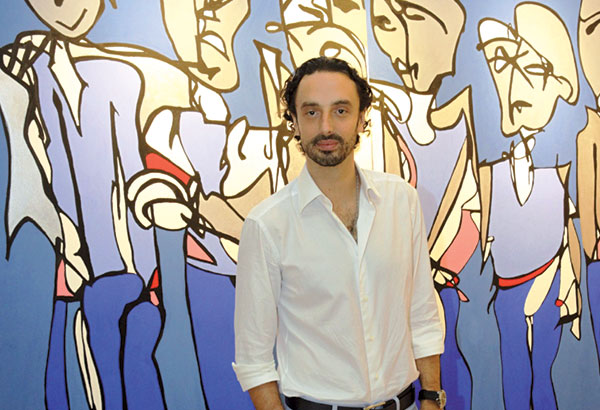
French-American
artist Alexander Charriol’s work may
be “autobiographical, but it is overwhelmingly universal–a visual poem that
tackles the entangled nature of who we are.”
From
the somber silhouettes that huddle together in the Tin Man Party to the prying
eyes that gloss over the provocative woman in Stop the Madness, the figures in
each of Charriol’s canvases tell the many stories of the human experience:
love, loneliness, selfishness, greed, discontent, as well as the need for human
connectedness.
 |
| Tin Man Party |
Charriol’s creative journey began in 2010 when
the graduate of Parsons School
of Design decided to move from New York to settle, almost
like a hermit, in the hills of Los Angeles. There, in isolation, he picked up
the brush and started painting. “I was very lonely, I lost my
friends, I lost everything,” reveals the 34-year-old, who admits to also having
fallen weak to drug abuse at that time, thus the self-imposed isolation. “I was
in a house with a beautiful view but no one around, so I got very lonely and
then so I started painting a lot of people.”
With
every stroke and brandish of color, Charriol allowed the “flow of feeling and
energy” to grow stronger and fill the space that had been left empty. The
therapeutic exercise turned into a creative one, and eventually led to an
epiphany: “Humans need touch. People need to be together. Without touch, without
being together, humans are not gonna survive,” explains Charriol.
 |
| Stop the Madness |
This
Human Flow concept permeated his work and persisted well into the creation of
his fourth installment in the series, which was exhibited recently at the Altro
Mondo Arte Contemporanea, Greenbelt 5, Makati City.
Excited for the newest collection, admirers and
fellow artists like National Artist
Arturo Luz, Betsy Westendorp, glass sculptor Ramon Orlina, former CCP president
Nestor Jardin, Ballet Philippines president Margie Moran Floriendo and Lane
Moving’s Virginia Lane dropped by to show support for their artist-friend.
“Painting
can be therapeutic at times when things are going great,” says Charriol. “But
once when you don’t know where you’re heading, anxiety starts to fill yourself.
No one’s telling you what to draw, what to do, so you really have to stay
focused and believe in what you’re doing,” he reveals, adding that when his
motivation is lagging, he retreats to his studios in New York and Bangkok. (Especially
in Bangkok, where his studio nestles on the bank of the river, Charriol finds
that he never runs out of inspiration.)
Looking
around the well-curated space of Altro Mondo, with the massive canvases
embracing entire walls, Charriol beams proudly at his work. “It’s good to hear
honest feedback. It’s a good feeling to get your art work out of the studio and
onto the walls.”
And perhaps also, he has realized it’s good to allow others to see themselves
in the pictures. We are, after all, connected. His story is their story.
No comments:
Post a Comment